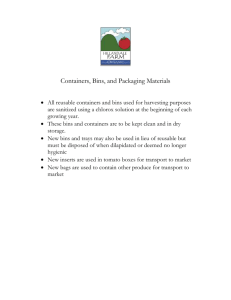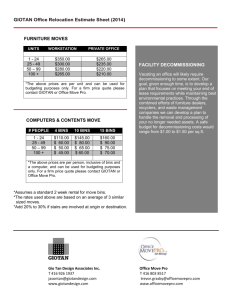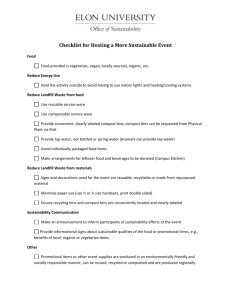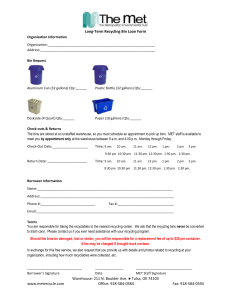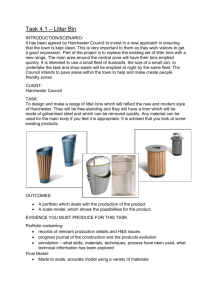Warehouse with a Manual ASRS - NUS Business School
advertisement
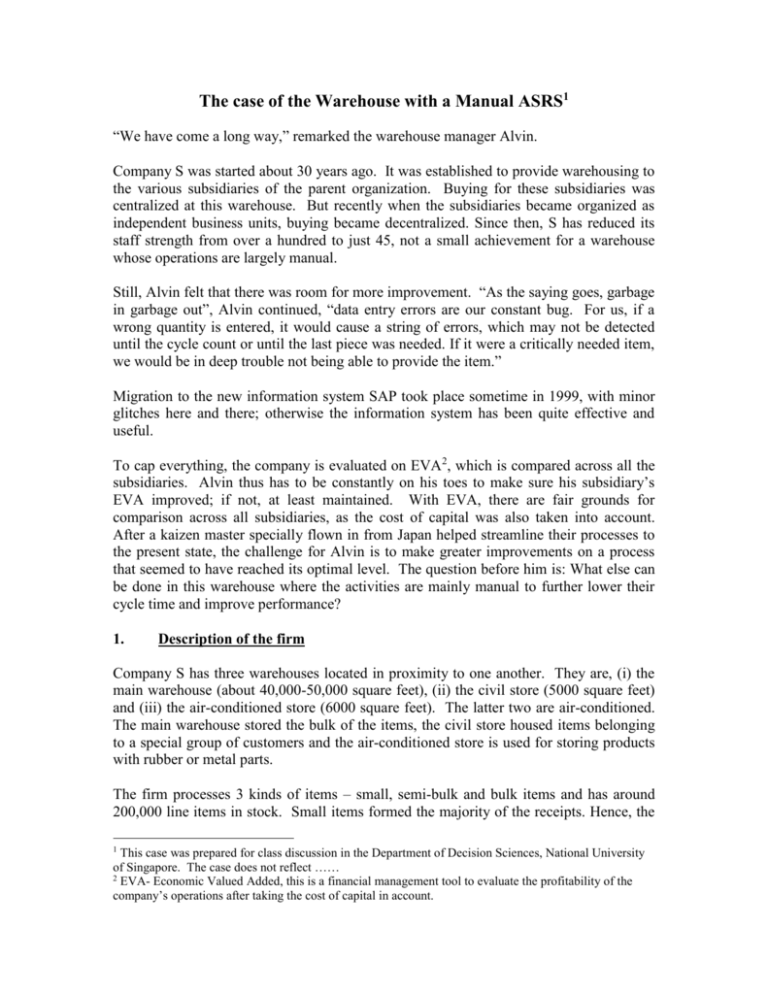
The case of the Warehouse with a Manual ASRS1 “We have come a long way,” remarked the warehouse manager Alvin. Company S was started about 30 years ago. It was established to provide warehousing to the various subsidiaries of the parent organization. Buying for these subsidiaries was centralized at this warehouse. But recently when the subsidiaries became organized as independent business units, buying became decentralized. Since then, S has reduced its staff strength from over a hundred to just 45, not a small achievement for a warehouse whose operations are largely manual. Still, Alvin felt that there was room for more improvement. “As the saying goes, garbage in garbage out”, Alvin continued, “data entry errors are our constant bug. For us, if a wrong quantity is entered, it would cause a string of errors, which may not be detected until the cycle count or until the last piece was needed. If it were a critically needed item, we would be in deep trouble not being able to provide the item.” Migration to the new information system SAP took place sometime in 1999, with minor glitches here and there; otherwise the information system has been quite effective and useful. To cap everything, the company is evaluated on EVA2, which is compared across all the subsidiaries. Alvin thus has to be constantly on his toes to make sure his subsidiary’s EVA improved; if not, at least maintained. With EVA, there are fair grounds for comparison across all subsidiaries, as the cost of capital was also taken into account. After a kaizen master specially flown in from Japan helped streamline their processes to the present state, the challenge for Alvin is to make greater improvements on a process that seemed to have reached its optimal level. The question before him is: What else can be done in this warehouse where the activities are mainly manual to further lower their cycle time and improve performance? 1. Description of the firm Company S has three warehouses located in proximity to one another. They are, (i) the main warehouse (about 40,000-50,000 square feet), (ii) the civil store (5000 square feet) and (iii) the air-conditioned store (6000 square feet). The latter two are air-conditioned. The main warehouse stored the bulk of the items, the civil store housed items belonging to a special group of customers and the air-conditioned store is used for storing products with rubber or metal parts. The firm processes 3 kinds of items – small, semi-bulk and bulk items and has around 200,000 line items in stock. Small items formed the majority of the receipts. Hence, the 1 This case was prepared for class discussion in the Department of Decision Sciences, National University of Singapore. The case does not reflect …… 2 EVA- Economic Valued Added, this is a financial management tool to evaluate the profitability of the company’s operations after taking the cost of capital in account. structures of the warehouses are designed to accommodate mainly the storage of small items. The storage mode in all the warehouses is racks. The main warehouse has three tiers of racks while the air-conditioned store has two tiers to make full use of the space bestowed by the high ceiling. The racks contain the bins. Small and semi-bulk items are put away in small and semi-bulk bins respectively. The small item bins, occupy the majority of the racks with the bottom row reserved for semi-bulk bins. Bulk items are put away in special racks or just on designated floor areas. Since the small item bins formed the greater part of the warehouse, they would just be referred to as bins. The matter of concern to the manager is the air-conditioned warehouse. Space seems limited for the high demand being experienced. One option for the management to augment air-conditioned warehouse space is to air-condition the main warehouse. The management feels that it not justified due to economic reasons. This decision leaves the manager with no choice but to find ways to manage the limited air-conditioned warehouse space better. 2. Description of the process “It’s like a manual ASRS,” explained Alvin. It is a paradoxical statement but that reflected their process well. This is a new system implemented in early 1999. Empty bins are brought upfront to the receiving department. At the receiving, the bins get filled with receipts. The bins are then put away in the racks. Each bin has a permanent location in the warehouse as stated in the address label affixed to it. This is akin to a ASRS. What was special in this case is that the bins are moved manually from its location on the rack to the receiving department and back. 2.1 Goods receipt The company received about 6000 line items per month, all ordered by the subsidiaries. When the goods arrived, Tay, who was in charge of goods receipt, would check the airway bill, sign and stamp on the documents to be returned to the courier. Normally each incoming shipment would consist of a big box that contained many smaller boxes inside. Thus one arrival from the courier would mean an assortment of items received, depending on what was ordered at the subsidiaries. Next, Tay would open the boxes and tally them with the documents he received from the courier. He would then put the relevant document with the item and place it in a queue for the next process, which is inspection. Inspection is done on a First-In-First-Out (FIFO) basis. Figure 1 – G/R area The goods receipt (G/R) area is divided into four lanes. (Refer to figure 1). Items received would be placed on these lanes from lanes 1 to 3 in the order of the date and time of arrival. The last lane is reserved for bigger items; hence its area is bigger than the first three. As seen from Figure 1, each arrival would be placed on a pallet. This facilitates moving them near the inspection area.. Frequently, Tay would move up the remaining arrivals once the earlier items were cleared. He does this by using a simple forklift to lift up the pallet and bring it forward. 2.1.1 Inspection Figure 2 shows the quality inspectors doing their work. Just before each inspector’s desk, a few employees are seated to check that the certificates issued for the items are correct They also verify the quantity by counting or weighing before passing it to the quality inspectors. This could be quite time consuming as some items come in large quantities and manual counting is what is done. Before actual inspection, the inspectors firstr key in the item purchase order number into the computer to check that it is the correct part and is in the right quantity ordered. This verification differed from the earlier checking at the receiving lane in that the quality inspectors look into the system to confirm, while the workers in the earlier stage only make sure that the documents corresponded to what they received. After making sure that the quantity and part is correct, they then inspect the items. The degree of inspection varied among the items. Figure 2 - Inspection Certain items need only general eyeball inspection while others go through more detailed inspection. There are very few samplings, as the less critical items would be just looked through while the critical items need to be individually inspected regardless of quantity. This often resulted in bottlenecks when the receipts are many. Figure 3 – labeling When the item passes the quality test, the inspector then keys in the relevant details and a label is automatically printed. As the empty bins are placed in proximity to the inspectors’ work area, they would have decided beforehand which bin to put the item into and scan in the address so that the label would include the storage address of the item. The current policy is to clear the items for binning within a day of receipt. Hence if there are many arrivals on a particular day, workers would do overtime to clear them as soon as possible. Nevertheless, they are doing it well ahead of their set target as officially, they have a time limit of 3 days to process them. 2.1.2 Allocating storage Figure 3 – awaiting binning After inspection, the items are packed, labeled and placed onto empty bins near the inspection area. When a substantial number of bins are filled up, another employee, Lim, puts away the bins into their respective locations on the warehouse racks. Figure 3 above illustrates the filled bins waiting to be put into the warehouse. Figure 4 – small item bins and semi-bulk bins. Figure 4 shows the 2 types of bins used in the warehouse – small item bins and semi-bulk bins. The small item bins each have three compartments and regulations dictated that a maximum of only five line items could be stored in each compartment. Hence theoretically, each bin could take up to fifteen small items. Figure 5 – bulk items awaiting storage After inspection, bulky items are moved to an area in front of the inspectors (figure 5). As they are not put into bins, they do not have permanent address. Lim is responsible for allocating space to them. He just follows a random allocation policy. He carts the items on a trolley into the warehouse. Upon finding a suitable location, he puts away the item there and writes down its address on the box and the document. After doing so for all the bulky items, he would then update the permanent address of the bulk items in the system. Semi-bulk bins are used to store larger items or those that come in greater quantities and are then contained in a bigger box. There is no restriction on the number of items that could go into a semi-bulk bin, but if too many items are placed inside, the order picker will take a longer time to locate the item. There are not many semi-bulk bins as the company started using them only recently. Hence, most of the semi-bulk items are put away to the racks in a random manner similar to bulk item storage allocation 2.2 Relocation The team of order pickers is in charge of replenishing empty bins to the receiving department. If the order pickers seem to run out of empty bins, the warehouse supervisor has to print out a report on the addresses of the empty and almost empty bins. Besides listing these bins, the system can also printout the items that are in a bin. An employee would then be dispatched to retrieve the empty bins during overtime. If there are not enough empty bins, the items remaining in the almost empty bins would be taken out and placed elsewhere. As the worker took out these items for relocation, he would make a record of it in the logbook and update into the system when he was done. The leftover items are not randomly allocated, but put into the first bin of that row. Thus, the first bin is normally not brought to the receiving area. This shifting of items is known as relocation. Statistics collected for relocation showed an increasing trend. This is because of the fact that demand for space in the civil and air-conditioned stores have been increasing, but supply remains fixed. The air-conditioned store in particular, is found to be 80% filled with slow3 or non-moving items. To worsen the situation, the random binning and the legacy system cause the fast moving items to be mixed with the rest. As a consequence the majority of the relocation is done in the air-conditioned store. The table below exhibits the relocation figures. No. of line items binned June 1999 84 July 1999 150 August 1999 310 September 1999 142 October 1999 152 November 1999 211 December 1999 197 January 2000 291 February 2000 569 March 2000 551 April 2000 1175 May 2000 1759 June 2000 1370 Table 1 – relocation figures4 Month No. of line items relocated 3113 5432 5652 5065 5635 6175 5641 1257 1149 1563 1526 1204 657 % relocation 2.70 2.76 5.48 2.80 2.70 3.42 3.49 23.15 49.52 35.25 77.00 68.45 47.96 Explanation of figures Initially, as new bins were bought in large quantities for the new system, there was availability of empty bins; hence there was less need for relocation. As the bins started to run out, more relocation had to be done (especially for the civil and air-conditioned stores). Past centralized purchasing resulted in greater safety stock; the change to decentralized purchasing meant less safety stock and movement of past stocks. In Jan 2000, many workers were on holiday and so there were fewer people doing the work. 2.3 Order picking & shipping The warehouse follows zone picking. The orders are consolidated every morning and a pick list is generated. The warehouse handles two types of orders, namely normal orders and expedited orders. Normal orders can be shipped within 1.5 days but the expedited orders must be shipped as soon as possible. The warehouse uses two separate computers for generating the pick lists for the normal and expedited orders. Sometimes the orders need to be picked from G/R. These are called “offline issues.” 3 Slow moving items are defined as having less than 3 issues in the past 2 years Relocation figures – records of earlier relocation were unavailable due to different reporting, accountabilities and process. These were the numbers for all 3 warehouses, but aircon store formed the majority. 4 The warehouse team is in charge of order picking and dispatch. There are 7 order pickers with 5 allocated to the main warehouse, 1 to the civil and aircon store and another to fulfill all emergency orders. The workers are rotated every month among the different locations to pick items. Every morning, each worker will be given a pick list that has been sorted by location. They also help one other if they have finished picking from their own area. If there are too many orders for that day, some of the workers will do overtime to finish picking the items. After the items have been picked, the picker brings them to the dispatch area and scans the items into the system before sorting into trays according to the customer. Normal orders are dispatched once a day, while the expedited orders have more frequent deliveries. Sometimes the subsidiaries send their own employees down to the warehouse to collect the item if the order is very urgent. 1.2.1 Issues of concern As pointed out earlier, the company is very much concerned about the frequent shortage of empty bins to be brought out to G/R for binning. There has been an increasing trend in the number of relocation activity by the warehouse team resulting in lower productivity. The company considers that the relocation activity is not a value-adding activity and so needs to be minimized, if not altogether eliminated. This company wishes to address the following questions: Will a class-based storage policy be beneficial? Will a division of 2 to 3 classes (ABC classification) based on the popularity of the parts, with a random storage policy in each class be better? Will implementing such policies lead to less partially filled bins and fewer stock outs of empty bins, thereby reducing the number of relocations needed?

